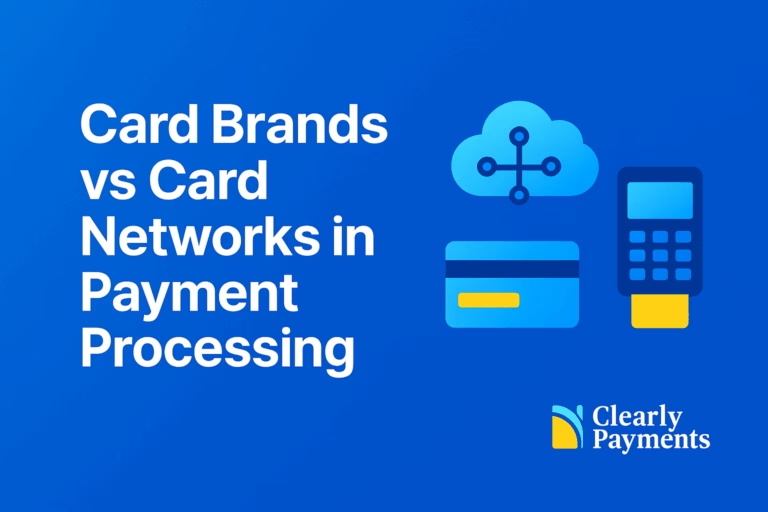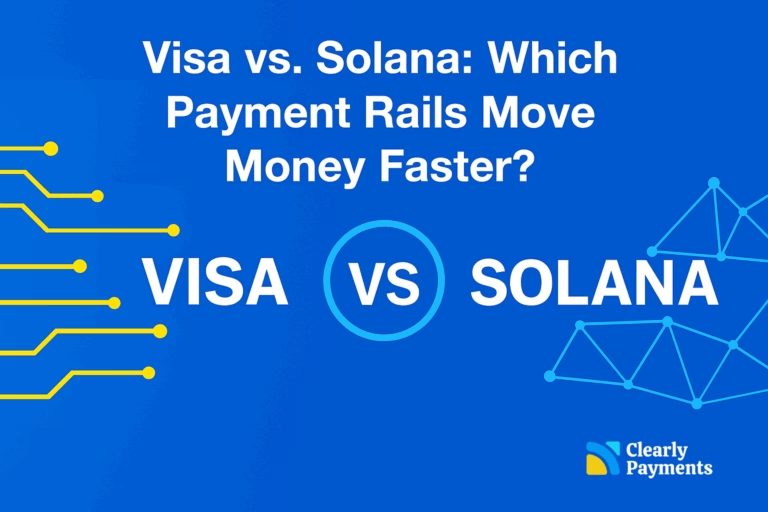For most merchants, “Visa,” “Mastercard,” or “Amex” are just logos on a terminal screen. Behind those logos lies a comprehensive ecosystem of brands, networks, banks, acquirers, and processors that all collaborate every time a customer taps or inserts a card.
This article breaks down what people mean by card brands and card networks, why the terms are often used interchangeably, and how this ecosystem affects your costs, approvals, and customer experience.
What are Card Brands
A card brand is what people see: the logo, the rewards program, the marketing, and the type of card in a customer’s wallet. Visa, Mastercard, American Express, and Discover are the most recognized card brands globally. In Canada, Interac is also a core brand for debit.
The brand sets expectations: what the card can do, the benefits it provides, and the rules that apply to both the merchant and the cardholder.
Card brand examples: Visa, Mastercard, American Express, Discover, Interac (in Canada, for debit), UnionPay, JCB, and domestic debit brands in other countries
The brand wraps together:
- The logo and marketing
- The cardholder benefits and rewards
- The rules for how the card can be used
- The pricing framework that issuers and acquirers work within
What are Card Networks
A card network is the technology layer and rules system that moves payment data between your processor, the cardholder’s bank, and the merchant’s bank.
When a customer taps a Visa card, the network determines how the authorization is routed, which fees apply, how risk checks are handled, and how funds ultimately settle. It is the infrastructure that keeps payments fast, secure, and consistent across millions of merchants.
In many cases, the brand and network are the same organization, which is why people use the terms interchangeably.
What a card network does:
- Routes authorizations in real time
- Applies network-specific rules
- Supports fraud tools and tokenization
- Clears and settles funds between financial institutions
In many cases, the brand and the network are the same organization. For example, Visa is both the brand on the card and the network that routes transactions. That is why the terms “card brand” and “card network” are often used interchangeably.
Where it gets more interesting is with:
- Domestic debit schemes (for example Interac in Canada) that can share space on a card with Visa or Mastercard
- Three-party models like American Express that are both issuer and network
- Digital wallets like Apple Pay and Google Pay that sit on top of card networks
Real-World Examples: Card Brands & Networks
Visa and Mastercard operate what is called a four-party model, where issuing banks create cards and acquiring partners (like Clearly Payments) sign merchants. American Express traditionally operates a three-party model, where Amex itself is issuer, acquirer, and network. Interac, in Canada, is a domestic debit network that handles most in-store debit transactions.
In some regions, one card can support more than one network. For example, a Canadian debit card may use Interac in-store but switch to Visa Debit or Debit Mastercard for online and international purchases. In this case, the brand on the physical card isn’t the whole story, the underlying network changes depending on how the transaction is processed.
Misconceptions of Card Brands And Networks
Here are a few things we often hear from merchants.
- “Visa sets my interest rate”: Interest rates, credit limits, and consumer fees come from the issuing bank, not the network. The network sets rules and fees for transactions between banks and acquirers.
- “My processor controls all my fees”: Your processor controls its markup and pricing model, but interchange and network assessments are set by the networks and banks. A good processor will explain which parts of your costs are passed through and which are the margin.
- “Apple Pay is a cheaper network”: Apple Pay and other wallets ride on top of the same card networks, usually at the same interchange rates as the underlying card. The benefits are reduced friction and improved security, not a completely different network fee structure.
Market Share Snapshots of Credit Cards in 2025
Card networks carry an enormous portion of global consumer spending.
- Globally, Visa processes about 32% of all credit card spending, Mastercard about 21%, and UnionPay (driven by China) about 35%, making these three giants responsible for roughly 97 percent of global card volume.
- In the United States, Visa accounts for about half of all card transactions, followed by Mastercard at roughly a quarter, then American Express and Discover.
- In Canada, debit and credit cards make up over 60% of all consumer payments and nearly 90% of businesses accept them.
- Contactless is now the dominant method for in-store payments. Recent studies show that over 60% of Canadian in-store transactions are tap-based.
These numbers highlight why card networks and brands matter: they handle most of your customers’ spending, every day.
Card Network Market Share (Global vs USA)
| Card Network | Global Share (%) | USA Share (%) |
|---|---|---|
| UnionPay | ~35% | <1% |
| Visa | ~32% | ~50% |
| Mastercard | ~21% | ~25% |
| American Express | ~4–5% | ~15% |
| Discover / Others | ~7–8% combined | ~8% |
Trends in Card Brands and Networks in 2025
The world of card brands and card networks is shifting quickly, especially as digital commerce accelerates. Below are the key trends shaping how payments work in 2025 and beyond.
Tokenization is becoming the default: Card networks increasingly replace card numbers with secure tokens in mobile wallets and online checkouts. This improves approval rates, lowers fraud, and makes recurring billing more stable.
Premium rewards cards continue to grow: Visa and Mastercard are adjusting interchange to support high-end reward programs. These cards are now a larger share of purchases and often come with higher acceptance costs for merchants.
Domestic debit networks are modernizing: Interac and other national debit schemes are expanding online support, improving contactless features, and offering more secure digital options. This makes debit a stronger and often cheaper alternative across more channels.
Co-badged cards are routing more dynamically: A single card may switch between networks based on whether the transaction is in-store, online, international, or recurring. This can change the fees a merchant pays, even when the same physical card is used.
Digital wallets are accelerating: Apple Pay, Google Pay, and other wallets continue to grow. Even though customers see the wallet brand, the transaction still runs on Visa, Mastercard, Amex, or Interac rails. Merchants benefit from stronger conversion and security.
Real-time payment systems are emerging: Bank-to-bank systems like FedNow, PIX, and open banking rails are gaining momentum. They create new alternatives for bill payments and transfers, while cards remain dominant for rewards, protections, and consumer trust.
Network security standards keep tightening: Fraud monitoring, authentication rules, and dispute requirements are becoming more rigorous. These improvements reduce fraud but also raise compliance expectations for merchants.
BNPL is being absorbed by the card networks: Visa and Mastercard are introducing Buy Now, Pay Later features through existing cards, making it easier for merchants to offer BNPL without additional integrations.
Commercial card use is increasing: More B2B transactions are moving online, and businesses are using corporate and purchasing cards more often. These typically come with higher interchange fees and stricter authorization patterns.




